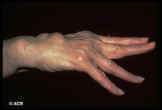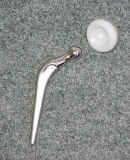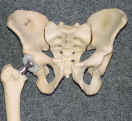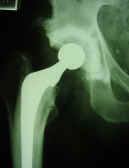Surgery

Synovectomy, may also prevent deterioration of the joint, and may be done with arthroscopy or as an open procedure.
In the case of large joint surgery, excessive delay may compromise bone stock, and therefore increase complexity of the procedure.
Wrist synovitis threatening tendons. Preventative surgery may avoid
rupture

ruptured tendons
Arthroscopic: Surgery is done via
visualization of the operative fields, through sophisticated fiber optic
technique. This is done through a narrow pipe. through which, cutting,
burring, and suturing, or stapling takes place.
Open surgery: Surgery is done with full visualization by making a full
incision into the tissues.
Arthrodesis: The fusion of bony surfaces and the joint - fixing the joint in
a functional position, and allowing no movement at all. Stopping such
movement helps stability and reduces pain.
Excision arthroplasty: This is the removal of the joint surface
leaving nothing between the adjacent bones. The major role is in the
metatarsal joints in the feet, and is the mainstay of bunion surgery.
Osteotomy: This involves the removal of a wedge of bone near the
joint thus correcting any angle deformity of the joint and re-aligning the
adjacent surfaces correctly.
Replacement arthroplasty: This is the medical term for joint
replacement surgery. It is done by removing the joint surfaces, and
replacing the surfaces with prosthetic material, which may or may not be
cemented into place. Such prosthetic material includes metal / ceramic / Scilastic
content.

Hip prosthesis
Prosthesis in place - model
Prosthesis - an xray post operative
1. Pain not controlled by medication / other methods.
2. Damage and functional impairment of daily life, not controlled by medication / other methods.
3. Neurological compression with nerve damage and weakness
With the exception of prevention surgery, timing of surgery can be planned and are not affected by age. However in the case of replacement surgery, age becomes a factor to be considered. The prostheses do not have infinite lifespan, and therefore delay in younger persons is optimal, where possible. This does not mean surgery is contraindicated in young people. The same principles apply - where quality of life is sufficiently disturbed, and all other methods have failed, then surgery should proceed.
Clearly - physical fitness for anesthetic is vital in making a decision to go ahead with surgery.
The major complications are early versus late. Early complications relate to the anesthetic complications, in all its forms, as well as surgical complications of bleeding and hematoma, and alignment problems i.e. technical problems of surgery. Late complications relate to general health problems, especially thrombosis and embolism of blood clot to the lungs. Surgical problems include infection and technical alignment problems or even dislocation or prosthesis failure.